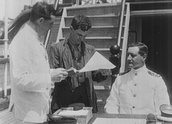


For the Honour of Australia (1916)
Synopsis
As Jack Lane finds himself orphaned and broke, he joins the Australian Navy and is inducted on the training ship, Tingira. His ne’er-do-well brother Stanley (Boyd Irwin) discovers a German spy ring amongst wealthy socialites in Sydney. They abduct him to a secret island outpost, where German sailors have landed to destroy a radio installation. HMAS Sydney receives a distress call before the radio is destroyed. She fires her first shots of the war at the German sailors. An island woman, Kana (Alma Rock Phillips), guides the Sydney to the spies’ island, where its guns open up on the enemy. Meanwhile, Jack Lane, now wounded, tells his shipmates of the Sydney’s fierce battle with the German raider Emden, near Cocos Island. On the spies’ island, a landing party attacks and kills the conspirators. Kana saves Stanley and is killed. Stanley carries her body back to the beach, declaring she died ‘for Australia’.
Curator’s notes
For the Honour of Australia is actually two films, cobbled together for screening in Britain. It was released there in November 1916, after the two films completed their run in Australia in late 1915. This process of cannibalising other films was not uncommon in the silent era, but in this case there was something unusual. There were two prominent production companies active in 1915 in Australia and they competed heavily, often to tell the same stories. Australasian Films and JC Williamson’s both made features about the Gallipoli landing, and these films opened within two days of each other in July 1915 (see The Hero of the Dardanelles and Gallipoli on Film). On 6 December 1915, both companies premiered films about the naval battle between HMAS Sydney and the German raider Emden. Williamson’s film was called For Australia; Australasian’s film was called How We Beat the Emden.
For the Honour of Australia combines both these films into an impossibly silly and remarkably crude piece of propaganda, but we are lucky they did, because this is how the film(s) survived. In fact, the copy held in Britain preserved fragments from three films, because How We Beat the Emden (1915) actually used footage of the wrecked ship taken from an earlier documentary – How We Fought the Emden (released in June 1915). Who put the films together for screening in Britain is unknown, but it appears to have been done with the approval of both the Australian and British governments, as a title at the beginning states that it is ‘presented by special permission of HM Board of Admiralty and the Minister for the Australian Navy’.
The two main films are of vastly different quality. For Australia, directed for JC Williamson’s by Monte Luke, is a melodrama about a newspaper reporter captured by a German spy ring and taken to a secret island, where he is saved by a native girl and the Sydney. How We Beat the Emden is about Jack, who becomes a sailor on the Sydney and recounts the battle with the Emden to his shipmates after he returns home wounded. Putting the two films together, the heroes are now brothers (with no scenes showing them together) and the Sydney is even more active than the real thing. We see no explanation of how the newspaper reporter gets abducted and taken to the island, nor any explanation of who Kana is. She just dies gallantly saving the man she barely knows and ‘for Australia’.
The preserved footage from Australasian’s How We Beat the Emden (1915) is the more valuable footage today because it shows the wreckage of the real Emden, and some interesting training footage on board the RAN training ship Tingira. This ship was well known to Sydneysiders before the war. Built in Aberdeen, Scotland, she was launched in 1866, as the Sobraon, and ran for 24 years between England and Australia. In 1891, she was sold to the NSW government to use as a floating reformatory for boys – or more properly ‘a nautical school’ ship for destitute boys.
She was sold to the Commonwealth in 1911, to become the first training ship of the newly formed Royal Australian Navy. For 15 years, the Tingira was moored at Rose Bay. The navy ran a recruiting scheme for boys in its early years and 3,168 of them received their initial training on this ship. Some of those who sailed on the Sydney when she took on the Emden were trained on the Tingira, so this footage of recruitment and training is very precious, albeit not entirely reliable (see clip one notes).
The wrecked Emden footage was shot by Charles Cusden, who was sent to Cocos on a specially chartered boat to film the wreck. His trip was financed by members of Sydney’s Millions Club. According to Australian Film 1900–1977 (Andrew Pike and Ross Cooper, Oxford University Press, 1980), he returned with 1000 feet of film which became the basis of a film about the Royal Australian Navy, How We Fought the Emden (1915).
When director Alfred Rolfe needed footage of the destroyed ship six months later for How We Beat the Emden (1915), he simply borrowed it from the documentary. Nothing remains of the original documentary except this footage; nor is there anything of the two original films cut together to make For the Honour of Australia. Whoever cut these films together was doing so for a short-term purpose – probably a mixture of propaganda and profit – but the inadvertent result was that parts of all three films ended up being preserved in Britain.
- Overview
- Curator’s notes
- Video 3 clips
- Principal credits
- Find a copy
- Make a comment
- Map
- Add your review



